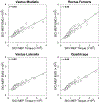Effect of paired-pulse stimulus parameters on the two phases of short interval intracortical inhibition in the quadriceps muscle group
- PMID: 31306142
- PMCID: PMC6995364
- DOI: 10.3233/RNN-180894
Effect of paired-pulse stimulus parameters on the two phases of short interval intracortical inhibition in the quadriceps muscle group
Abstract
Background: Short interval intracortical inhibition (SICI) is commonly used to assess inhibition in the motor cortex and is known to be affected by the paired-pulse stimulus parameters (i.e., interstimulus interval [ISI], conditioning stimulus intensity [CSI] and test stimulus intensity [TSI]) used during testing. While the effects of stimulus parameters are well-studied in the upper-extremity, evidence in the lower-extremity is lacking.
Objective: To comprehensively examine the effects of alterations in paired-pulse stimulus parameters on the two phases of SICI in the quadriceps muscle group.
Methods: Seventeen adults (8 males, 9 females) volunteered to participate in this study. SICI was examined over a range of CSIs (70-90% active motor threshold [AMT]), TSIs (100-140% AMT), and ISIs (1.0-3.0 ms) using both EMG and torque responses elicited by transcranial magnetic stimulation (TMS).
Results: The results indicated that SICI at 1.0 ms ISI was best revealed with a CSI of 70% and TSI ≥110% AMT, whereas SICI at 2.5 ms ISI was best revealed with a CSI of 80-90% and a TSI of ≥130% AMT. Unlike upper-extremity muscles, evaluating SICI with a CSI of 70% AMT and an ISI of 1.0 ms produced the greatest inhibition for all TSIs. In general, inhibitory effects were contaminated by facilitatory effects when using a TSI of 100% AMT.
Conclusions: The amount of inhibition was dependent on the stimulation parameters used during testing. A CSI of 70% AMT, ISI of 1.0 ms, and TSI of ≥110% AMT appear to be optimal for measuring SICI in the quadriceps muscle; however, other parameters can be used if careful consideration is given to the described interaction between the parameters.
Keywords: Cortical excitability; bayesian; knee; paired-pulse stimulation; twitch; two phases.
Figures




Similar articles
-
Interference of short-interval intracortical inhibition (SICI) and short-interval intracortical facilitation (SICF).Clin Neurophysiol. 2008 Oct;119(10):2291-7. doi: 10.1016/j.clinph.2008.05.031. Epub 2008 Aug 23. Clin Neurophysiol. 2008. PMID: 18723394
-
A time-efficient method to determine parameters for measurement of short-interval intracortical inhibition for quadriceps.Eur J Neurosci. 2020 Dec;52(12):4751-4761. doi: 10.1111/ejn.14904. Epub 2020 Jul 25. Eur J Neurosci. 2020. PMID: 32652725
-
Short Interval Intracortical Inhibition Responses to Low-Frequency Repetitive Transcranial Magnetic Stimulation Under Multiple Interstimulus Intervals and Conditioning Intensities.Neuromodulation. 2018 Jun;21(4):368-375. doi: 10.1111/ner.12773. Epub 2018 Mar 22. Neuromodulation. 2018. PMID: 29566289 Free PMC article.
-
An optimal protocol for measurement of corticospinal excitability, short intracortical inhibition and intracortical facilitation in the rectus femoris.J Neurol Sci. 2018 Nov 15;394:45-56. doi: 10.1016/j.jns.2018.09.001. Epub 2018 Sep 5. J Neurol Sci. 2018. PMID: 30216757
-
The effects of cerebellar stimulation on the motor cortical excitability in neurological disorders: a review.Cerebellum. 2005;4(4):218-23. doi: 10.1080/14734220500277007. Cerebellum. 2005. PMID: 16321876 Review.
Cited by
-
Neuromuscular characteristics of eccentric, concentric and isometric contractions of the knee extensors.Eur J Appl Physiol. 2025 Mar;125(3):671-686. doi: 10.1007/s00421-024-05626-9. Epub 2024 Oct 5. Eur J Appl Physiol. 2025. PMID: 39367883 Free PMC article.
-
Shaping corticospinal pathways in virtual reality: effects of task complexity and sensory feedback during mirror therapy in neurologically intact individuals.J Neuroeng Rehabil. 2024 Sep 4;21(1):154. doi: 10.1186/s12984-024-01454-2. J Neuroeng Rehabil. 2024. PMID: 39232841 Free PMC article.
-
Effect of conventional transcranial direct current stimulation devices and electrode sizes on motor cortical excitability of the quadriceps muscle.Restor Neurol Neurosci. 2021;39(5):379-391. doi: 10.3233/RNN-211210. Restor Neurol Neurosci. 2021. PMID: 34657855 Free PMC article.
-
How Does Ankle Mechanical Stiffness Change as a Function of Muscle Activation in Standing and During the Late Stance of Walking?IEEE Trans Biomed Eng. 2022 Mar;69(3):1186-1193. doi: 10.1109/TBME.2021.3117516. Epub 2022 Feb 18. IEEE Trans Biomed Eng. 2022. PMID: 34606446 Free PMC article.
-
Functional Resistance Training to Improve Knee Strength and Function After Acute Anterior Cruciate Ligament Reconstruction: A Case Study.Sports Health. 2021 Mar;13(2):136-144. doi: 10.1177/1941738120955184. Epub 2020 Dec 18. Sports Health. 2021. PMID: 33337984 Free PMC article.
References
-
- Akima H, Saito A, Watanabe K & Kouzaki M (2012). Alternate muscle activity patterns among synergists of the quadriceps femoris including the vastus intermedius during low-level sustained contraction in men. Muscle and Nerve, 46(1), 86–95. - PubMed
-
- Bashir S, Vernet M, Najib U, Perez J, Alonso-Alonso M, Knobel M, Yoo WK, Edwards D & Pascual-Leone A (2016). Enhanced motor function and its neurophysiological correlates after navigated low-frequency repetitive transcranial magnetic stimulation over the contralesional motor cortex in stroke. Restorative Neurology and Neuroscience, 34(4), 677–689. - PMC - PubMed
-
- Bawa P & Murnaghan C (2009). Motor unit rotation in a variety of human muscles. Journal of Neurophysiology, 102(4), 2265–2272. - PubMed
-
- Benjamini Y & Hochberg Y (1995). Controlling the false discovery rate: a practical and powerful approach to multiple testing. Journal of the Royal statistical society: series B (Methodological), 57(1), 289–300.
-
- Brownstein CG, Ansdell P, Skarabot J, Frazer A, Kidgell D, Howatson G, Goodall S & Thomas K (2018a). Motor cortical and corticospinal function differ during an isometric squat compared with isometric knee extension. Experimental Physiology. - PubMed
Publication types
MeSH terms
Grants and funding
LinkOut - more resources
Full Text Sources

